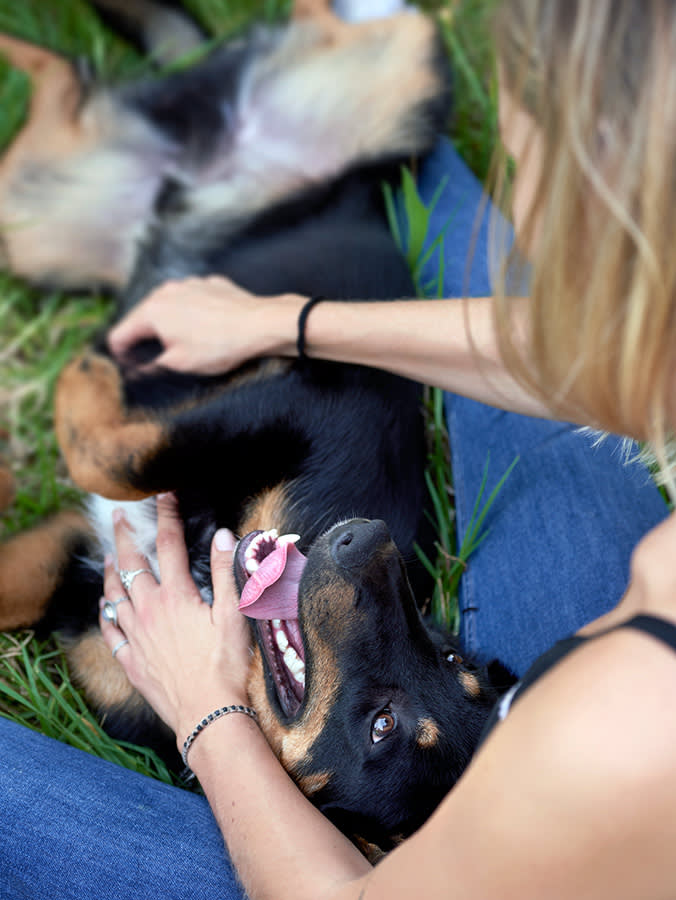How to Tell If Your Dog Is Pregnant
And what to look for week by week.
In This Article:
Signs of Pregnancy in Dogs Signs of Pregnancy in Dogs Week by Week Signs of False Pregnancy in Dogs
Suspecting that your dog might be pregnant can be both exciting and overwhelming, especially if you’re not sure what signs to look for. Recognizing the early indications of pregnancy helps ensure that your pup receives proper care throughout her gestation period.
Snap a pic of your pup’s teeth, and GREENIES™ will help you spot potential signs of oral health issues.
Signs of pregnancy in dogs
Determining a male dog’s ability to reproduce is pretty straightforward — just look for testicles. However, knowing whether an adult female dog is spayed can be a challenge, especially if there are no medical records or definitive spay scar.
Many dog parents and foster families find themselves in this position: you have a new dog and her medical history is unknown. You don’t know if she’s spayed, so you wait for signs of heat (estrus). But instead, her belly starts to get bigger. Now you’re wondering how to know if your dog is pregnant. Well, here are some common indicators:
How much do you spend on your pet per year?
Enlarged mammary glands
Enlarged, pinker nipples
Weight gain
Vaginal discharge
Decreased appetite
Occasional vomiting
Clingy or affectionate behavior
If you’re concerned that your dog may be pregnant, see your veterinarian for confirmation. Knowing how to tell if your small dog is pregnant may be easier than it would be if your dog were larger. Signs like rounded abdomen are easier to see in small, short-haired dogs. Depending on how far along your dog is, confirmation of pregnancy is often achieved by hormone testing, palpation, or imaging (ultrasound or radiographs).
Signs of pregnancy in dogs week by week
Pregnancy in dogs lasts about 65 days. The exact number of days can vary depending on where a dog is in her reproductive cycle when she was bred. If you’re concerned that your dog may be expecting, be sure to consult with your vet to provide the best prenatal care for your pup. Here’s a week-by-week breakdown of what happens and what to expect.
Weeks one to two: Fertilization and implantation
Eggs get fertilized and hormones shift to support pregnancy.
What you see: Not much, really. There’s not a good way to tell if your dog is two weeks pregnant because there are no external signs of pregnancy at this time.
Weeks three to four: Early fetal development
The fetuses start to take shape and can often be detected by ultrasound (though this takes some skill). A fetal heartbeat can be detected by day 25 and is often used to confirm pregnancy in dogs.
What you see: Your dog’s nipples may become enlarged and more pink in color. She may also produce small amounts of mucoid vaginal discharge. Some dogs experience occasional bouts of nausea and vomiting, similar to morning sickness.
Weeks five to six: Visible pregnancy
Puppy skeletons have developed and are visible on radiographs at the end of this period, around day 45, so pregnancy can easily be confirmed and the size of the litter can be estimated.
What you see: Your dog’s abdomen will get noticeably bigger. Your dog may display behavior changes like increased affection or clinginess. She’ll also want more food and will need the extra nutrients to keep up the demands of pregnancy. Switch to a puppy/growth diet and increase food intake by 10 percent each week.
Weeks seven to eight: Nesting and preparation
The puppies are almost full-sized and your dog’s abdomen will be large.
What you see: Because the puppies are taking up so much space in her abdomen, your dog may not tolerate large meals; small, frequent meals may be the way to go. She will likely start lactating and displaying nesting behavior in preparation for giving birth.
Week nine: Labor and delivery
Your dog will give birth to the puppies. Signs of impending labor include restlessness, panting, nesting, loss of appetite, and a drop in body temperature. Be sure to provide a whelping box and a calm, quiet area for the birthing process.
Normal canine estrus cycle
To understand how false pregnancy happens, you should know how a dog’s normal estrus cycle works. Trust me, this won’t be a long story about the birds and the bees. But we will talk about hormones and stuff.
There are four stages in a dog’s estrus cycle: proestrus, estrus, diestrus, and anestrus.
Proestrus: A dog’s body gets ready for mating. The ovaries produce estrogen leading to a swollen vulva and some vaginal discharge.
Estrus: A dog is most fertile and willing to mate. There is a surge of luteinizing hormone (LH), which triggers ovulation.
Diestrus: A dog’s body gets ready for pregnancy, even if mating didn't happen. There’s an increase in progesterone, the hormone that helps the body prepare for pregnancy. At the end of diestrus, progesterone levels fall and prolactin levels increase. Prolactin is the hormone that stimulates many physical and behavioral changes associated with pregnancy. This is when false pregnancy happens.
Anestrus: This is the period between cycles. There is minimal hormonal activity and the uterus is able to recover from pregnancy.
Signs of false pregnancy in dogs
False pregnancy is thought to develop due to quick decrease in progesterone and increase in prolactin during diestrus. This condition is seen in intact dogs and in dogs that undergo spaying during diestrus, though this is uncommon.
Signs of false pregnancy in dogs mimic those of true pregnancy and can include:
Swollen mammary glands
Lactation
Decreased appetite
Nesting behavior
“Mothering” toys and other objects
Protective behavior of “mothered” toys and objects
Change in activity level (an increase or decrease can be seen)
Diagnosis and treatment of false pregnancy in dogs
Determining that a dog is having a false pregnancy can be simple if she is known to be spayed or to never have mated. When a dog’s history is fuzzy, a diagnosis can be made through physical examination, imaging, or a blood test.
Most cases of false pregnancy resolve on their own within three weeks and do not require treatment. However, medication to reduce the prolactin hormone may be recommended in dogs that are lactating or that have symptoms that don’t seem to be resolving. After signs have cleared up, spaying intact females can prevent future episodes.
FAQs (People also ask):
What are early signs of pregnancy in dogs?
Early signs of pregnancy in dogs can include enlarged mammary glands, enlarged nipples, pinker nipples, vaginal discharge, weight gain, decreased appetite, and occasional vomiting.
When should you spay or neuter your dog?
The ideal age to spay or neuter your dog depends on size. In general, small and medium dogs should be spayed/neutered around six months of age. Large and giant breed dogs should wait until they’re done growing, which is usually between 9 and 15 months.
How to puppy proof your home?
Puppy parents can protect their pups from harm by keeping potential hazards like electrical cords, trash, houseplants, and cherished shoes out of reach. Crate training a puppy can also give them a safe space and keep them out of trouble.
References:
Parturition Prediction and Timing of Canine Pregnancyopens in new tab
Merck Veterinary Manual - Pseudopregnancy in Small Animalsopens in new tab
Veterinary Partner - False Pregnancy in Dogsopens in new tab
Understanding and Monitoring Canine Pregnancy - WSAVA 2005











